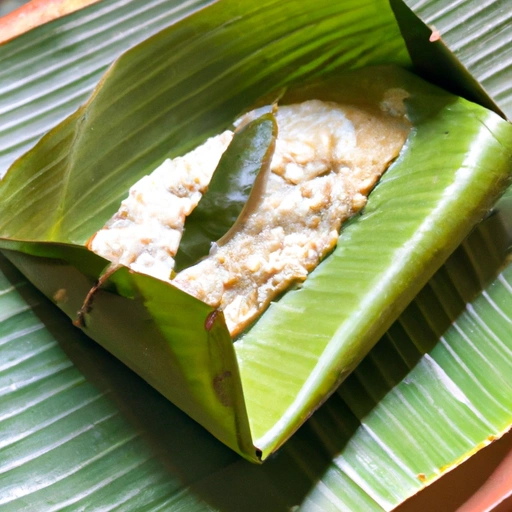Kiri Buth
Kiri Buth Recipe - Sri Lankan Vegetarian Dish with Rice and Coconut Milk
Introduction

Kiri Buth is a traditional Sri Lankan dish made with rice and coconut milk. It is a simple yet delicious recipe that is perfect for a comforting meal.
History
Kiri Buth has been a staple in Sri Lankan cuisine for generations. It is often served at special occasions and celebrations, as well as for everyday meals.
Ingredients
- 250 g of rice
- 250 ml of water
- 375 ml of thick coconut milk
- 0.5 tsp of salt
How to prepare
- Wash the rice and place it in a pan along with the water.
- Bring it to a boil and simmer until the rice becomes soft.
- Add the coconut milk and salt, and mix well using a wooden spoon.
- Cover the pan and simmer over a low flame until the milk is absorbed.
- Transfer the rice onto a shallow serving dish and flatten it smoothly.
- Cut it into diamond or square shapes.
Variations
- Add raisins or cashew nuts for a touch of sweetness and crunch.
- Use different types of rice such as basmati or jasmine for a different texture.
Cooking Tips & Tricks
Be sure to wash the rice thoroughly before cooking to remove any excess starch.
- Stir the rice frequently while cooking to prevent it from sticking to the bottom of the pan.
- Adjust the amount of coconut milk to your desired consistency - some prefer a creamier texture while others prefer a drier rice dish.
Serving Suggestions
Kiri Buth can be served with a side of spicy curry or chutney for added flavor.
Cooking Techniques
Simmering, boiling, and steaming are the main cooking techniques used in preparing Kiri Buth.
Ingredient Substitutions
You can substitute regular milk for coconut milk if desired, but the flavor will be different.
Make Ahead Tips
Kiri Buth can be made ahead of time and stored in the refrigerator for up to 2 days.
Presentation Ideas
Serve Kiri Buth on a decorative platter garnished with fresh herbs or edible flowers for a beautiful presentation.
Pairing Recommendations
Kiri Buth pairs well with spicy curries, pickles, and sambols.
Storage and Reheating Instructions
Store any leftovers in an airtight container in the refrigerator. Reheat in the microwave or on the stovetop until heated through.
Nutrition Information
Calories per serving
Each serving of Kiri Buth contains approximately 300 calories.
Carbohydrates
Each serving of Kiri Buth contains approximately 40g of carbohydrates.
Fats
Each serving of Kiri Buth contains approximately 15g of fats.
Proteins
Each serving of Kiri Buth contains approximately 5g of proteins.
Vitamins and minerals
Kiri Buth is a good source of vitamin B and iron.
Alergens
Kiri Buth contains coconut milk, which may be an allergen for some individuals.
Summary
Kiri Buth is a nutritious dish that provides a good balance of carbohydrates, fats, and proteins.
Summary
Kiri Buth is a classic Sri Lankan dish that is easy to make and full of flavor. Enjoy this comforting rice and coconut milk dish for a delicious meal any time of day.
How did I get this recipe?
The first time I saw this recipe, I was immediately intrigued. It was a hot summer day, and I was visiting my friend Maria in her small village in Sri Lanka. As we sat on her veranda sipping tea, she told me about a traditional dish called Kiri Buth that her grandmother used to make.
Maria described it as a creamy rice dish cooked in coconut milk and flavored with aromatic spices like cinnamon, cardamom, and cloves. My mouth watered just thinking about it. I begged her to show me how to make it, and she happily agreed.
We headed to the local market to gather all the ingredients we needed. Maria taught me how to choose the best coconut milk, how to pick the freshest spices, and how to select the perfect rice for the dish. As we walked through the bustling market, she shared stories about her grandmother and the love and care she put into every meal she made.
Back at Maria's house, we got to work. She showed me how to prepare the rice by washing it until the water ran clear, then toasting it in a dry pan until it was lightly golden. Next, we simmered the rice in coconut milk and water until it was tender and creamy, stirring constantly to prevent it from sticking to the bottom of the pot.
As the rice cooked, the kitchen filled with the warm, comforting scents of the spices. I could hardly contain my excitement as Maria added the cinnamon, cardamom, and cloves to the pot, along with a pinch of salt to bring out the flavors.
Finally, the Kiri Buth was ready. Maria ladled it into bowls and garnished it with a sprinkle of toasted coconut and a drizzle of ghee. We sat down at the table and dug in, savoring every bite of the creamy, fragrant rice.
As I ate, I felt a connection to Maria's grandmother and the generations of women who had passed down this recipe through the years. I realized that food is more than just sustenance – it is a way to connect with our past, to honor our traditions, and to share love and warmth with those we care about.
Since that day, Kiri Buth has become a staple in my own kitchen. I make it for my family and friends, sharing the story of how I learned to make it from Maria in her village in Sri Lanka. And every time I take that first bite of creamy, fragrant rice, I am transported back to that hot summer day, sitting on Maria's veranda, surrounded by the sights, sounds, and smells of a place that will always hold a special piece of my heart.
Categories
| Coconut Milk Recipes | Rice Recipes | Sri Lankan Recipes | Sri Lankan Vegetarian |